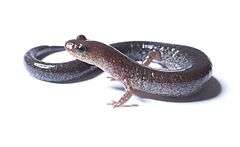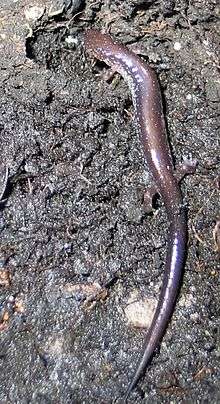Red-backed salamander
The red-backed salamander (Plethodon cinereus) is a species of small, hardy woodland salamander in the family Plethodontidae. The species inhabits wooded slopes in eastern North America, west to Missouri, south to North Carolina, and north from southern Quebec and the Maritime provinces in Canada to Minnesota. It is also known as the redback salamander,[3] eastern red-backed salamander,[3] or the northern red-backed salamander to distinguish it from the southern red-backed salamander (Plethodon serratus). It is one of 57 species in the genus Plethodon.
| Red-backed salamander | |
|---|---|
 | |
| "Leadback" phase | |
| Scientific classification | |
| Kingdom: | Animalia |
| Phylum: | Chordata |
| Class: | Amphibia |
| Order: | Urodela |
| Family: | Plethodontidae |
| Subfamily: | Plethodontinae |
| Genus: | Plethodon |
| Species: | P. cinereus |
| Binomial name | |
| Plethodon cinereus (Green, 1818) | |
| Synonyms[2] | |
| |
Description and ecology
The red-backed salamander is a small terrestrial salamander, 5.7–10.0 cm (2.2–3.9 in) in total length (including tail), which usually lives in forested areas under rocks, logs, bark, and other debris.[4] It is one of the most numerous salamanders throughout its range.[4] The red-backed salamander exhibits color polymorphism and two color variations are common: the "red-backed" or "red-stripe" variety has a red dorsal stripe that tapers towards the tail, and the darker variety, known as the "lead-backed" (or simply "lead") phase, lacks most or all of the red pigmentation.[4] The red-backed phase is not always red, but may actually be various other colors (e.g., yellow-backed, orange-backed, white-backed, or a rare erythristic morph in which the body is completely red).[4] Both morphs have speckled black and white bellies.[4] Additional color anomalies of this species also exist, including iridistic, albino, leucistic, amelanistic, and melanistic anomalies.[5] These color morphs are rarer than the red-backed, lead-backed, and erythristic morphs, but still have been reported with consistency among varying populations of this species.[5]
The skin of red-backed salamanders was found to contain Lysobacter gummosus, an epibiotic bacterium that produces the chemical 2,4-diacetylphloroglucinol and inhibits the growth of certain pathogenic fungi.[6]

Behavior
Antipredator behavior of P. cinereus was found to differ between the two color phases; the lead-backed phase has a tendency to run away from predators, whereas the red-backed phase often stays immobile and possibly exhibits aposematic coloration.[7] Stress levels of each color phase were estimated by determining the ratio of neutrophil to lymphocyte cells in the blood, and the results suggest stress levels are higher in the lead-backed phase than in the red-backed phase.[8] This may be a consequence of a higher predation risk experienced in the wild by the lead-backed phase, and may also mean lead-phase salamanders could be more vulnerable in captivity settings.[8]
Plethodon cinereus, like many plethodon species, exhibit homing behavior, with homing of females to their nests, as well as non-attending females and males to a home range.[9] This allows for essential contact between a female and her eggs in order to ensure their survival, as well as for non-attending females and males to explore beyond the home range when under predation pressures, or searching for food or cover, and return to their home range if a more favorable microhabitat is not found.[9]
Reproduction and biomass
Males and females of P. cinereus typically establish separate feeding and/or mating territories underneath rocks and logs. However, some red-backed salamanders are thought to engage in social monogamy, and may maintain codefended territories throughout their active periods. Breeding occurs in June and July. Females produce from four to 17 eggs in a year. The eggs hatch in 6 to 8 weeks. Not much is known about the dispersal of neonates, although neonates and juveniles are thought to be philopatric.The species largely consumes invertebrates and other detritus dwellers. In some areas with good habitat, these salamanders are so numerous, their population densities may surpass 1,000 individuals per acre (2,471 individuals per hectare). Pokagon State Park in Indiana is one such place.[10]
As in many Plethodon species, female red-backed salamanders have the ability to store sperm as spermatophore, and have been evidenced in doing so up to eight months prior to the oviposition period in June and July.[11] Sperm or spermatophores are not retained following the oviposition period.[11]
References
- IUCN SSC Amphibian Specialist Group (2014). "Plethodon cinereus". IUCN Red List of Threatened Species. 2014. Retrieved 2015-01-16.CS1 maint: ref=harv (link)
- Stejneger L, Barbour T (1917). A Check List of North American Amphibians and Reptiles. Cambridge, Massachusetts: Harvard University Press. 125 pp. (Plethodon cinereus, p. 15).
- Integrated Taxonomic Information System [Internet] 2012. [updated 2012 Sept; cited 2012 Nov 26] Available from: www.itis.gov
- Conant R, Collins JT (1998). A Field Guide to Reptiles and Amphibians of Eastern and Central North America, Third Edition. Boston: Houghton Mifflin. 616 pp. ISBN 0-395-90452-8.
- Moore, Jean-David; Ouellet, Martin (2014-10-16). "A review of colour phenotypes of the Eastern Red-backed Salamander, Plethodon cinereus , in North America". The Canadian Field-Naturalist. 128 (3): 250–259. doi:10.22621/cfn.v128i3.1603. ISSN 0008-3550.
- Brucker, Robert M.; Baylor, Cambria M.; Walters, Robert L.; Lauer, Antje; Harris, Reid N.; Minbiole, Kevin P. C. (2008). "The Identification of 2,4-diacetylphloroglucinol as an Antifungal Metabolite Produced by Cutaneous Bacteria of the Salamander Plethodon cinereus". Journal of Chemical Ecology. 34 (1): 39–43. doi:10.1007/s10886-007-9352-8. PMID 18058176.
- Venesky, Matthew D.; Anthony, Carl D. (2007). "Antipredator adaptations and predator avoidance by two color morphs of the eastern red-backed salamander, Plethodon cinereus". Herpetologica. 63 (4): 450–458. doi:10.1655/0018-0831(2007)63[450:AAAPAB]2.0.CO;2.
- Davis AK, Milanovich JR (2010). "Lead-phase and red-stripe color morphs of red-backed salamanders Plethodon cinereus differ in hematological stress indices: A consequence of differential predation pressure?" Current Zoology 56 (2): 238–243.
- Kleeberger, Steven R.; Werner, J. Kirwin (1982). "Home Range and Homing Behavior of Plethodon cinereus in Northern Michigan". Copeia. 1982 (2): 409–415. doi:10.2307/1444622. ISSN 0045-8511. JSTOR 1444622.
- APPALACHIAN NATURE: An Entrée of Salamanders
- Sayler, Anne (1966). "The Reproductive Ecology of the Red-Backed Salamander, Plethodon cinereus, in Maryland". Copeia. 1966 (2): 183–193. doi:10.2307/1441125. ISSN 0045-8511. JSTOR 1441125.
Further reading
- Behler JL, King FW (1979). The Audubon Society Field Guide to North American Reptiles and Amphibians. New York: Alfred A. Knopf. 743 pp., 657 color plates. ISBN 0-394-50824-6. (Plethodon cinereus, pp. 336-337 + Plates 71, 117).
- Green R (1818). "Descriptions of several species of North American Amphibia, accompanied with observations". Journal of the Academy of Natural Sciences of Philadelphia 1 (2): 348-359. (Salamandra cinerea, new species, pp. 356-357). (in English and Latin).
- Powell R, Conant R, Collins JT (2016). Peterson Field Guide to Reptiles and Amphibians of Eastern North America, Fourth Edition. Boston and New York: Houghton Mifflin Harcourt. 494 pp., 47 color plates, 207 Figures. ISBN 978-0-544-12997-9. (Plethodon cinereus, pp. 78-80 + Plate 5 + Figures 33, 36, 37).
- Zim HS, Smith HM (1956). Reptiles and Amphibians: A Guide to Familiar American Species: A Golden Nature Guide. Revised Edition. New York: Simon and Schuster. 160 pp. (Plethodon cinereus, pp. 147, 157).
External links
![]()
